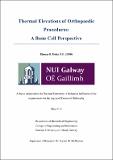| dc.description.abstract | Thermal elevations experienced by bone during orthopaedic procedures, such as cutting and drilling, exothermal reactions from bone cement, and thermal therapies such as tumour ablation, can result in thermal damage leading to death of bone cells (osteocytes, osteoblasts, osteoclasts and mesenchymal stem cells). Osteocytes are believed to act as orchestrators of bone remodeling by recruiting osteoclasts and activating nearby osteoblasts to control resorption and bone growth. Postsurgical healing of bone tissue is essential to ensure the success of an operation, and as such, a thorough biological understanding of the thermally induced responses of bone cells, in particular osteocytes, to clinically relevant thermal elevations is required. The global aim of this thesis is to discern the direct effects of clinically relevant temperatures on bone cell damage, mineralisation capacity and gene expression responses to initiate remodelling, using both in vitro and in vivo models.
The complex hierarchical structure of bone tissue renders the characterisation of thermal elevations arising from surgical procedures a particularly challenging task. As such, the precise temperatures experienced within the bone, particularly by embedded osteocytes, have never been explored. The first study presented in this thesis used a combination of experimental thermal imaging technology and multi-scale computational models to predict temperatures in bone tissue and cells with respect to various cutting parameters. These predicted temperatures (45 - 60°C for 30 - 60 seconds) informed the experimental studies of subsequent Chapters, which investigated the effects of such thermal elevations on bone cells.
Experimental methods were developed to determine thermally induced necrosis and apoptosis, mineralisation capacity and remodelling gene expression responses of bone cells in vitro. These studies demonstrated that thermally induced necrosis, apoptosis and viability were dependent on the degree of temperature elevation, the duration of exposure and the phenotype of the cell. Specifically, osteocyte-like MLO-Y4 cells were shown to be more resilient to heat-treatment than osteoblast-like MC3T3-E1 cells (as indicated by percentage apoptosis, necrosis, viability and population size), which may reflect the sensory role of native osteocytes in vivo, detecting damage and signalling to neighbouring cells to regulate bone healing. Additionally, it was shown that severe thermal elevations for clinically relevant durations enhanced mineralised matrix production by osteoprogenitors. Furthermore, a link between osteocyte thermal damage, and bone remodelling responses was identified, whereby heat treated MLO-Y4s elicited a remodelling response by activating nearby MLO-Y4s to initiate pro-osteoclastic and pro-osteoblastic gene expression, as well as directly inducing osteogenic differentiation of nearby pre-osteoblastic MSCs. Finally, a novel in vivo animal model established the vital role of native osteocytes in initiating the thermally induced responses in vivo, whereby heat treatment to 47°C and 60°C induced significant tissue death and osteocyte apoptosis, as well as pro-osteoclastic and pro-osteoblastic gene expression, and that these responses were dependent on the severity of heat treatment.
Thus, the studies presented in this thesis provide a novel biological understanding of thermally induced cellular responses in bone tissue at temperatures relevant to orthopaedic cutting procedures. The information elucidated from this body of work will inform the future development of orthopaedic cutting techniques that can minimise thermal elevations in bone tissue in order to optimise postsurgical healing, but can also inform the development of thermally active materials and thermal therapies for treatment of bone pathologies. | en_US |


